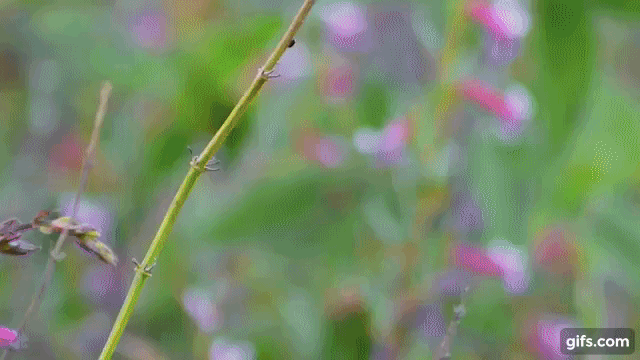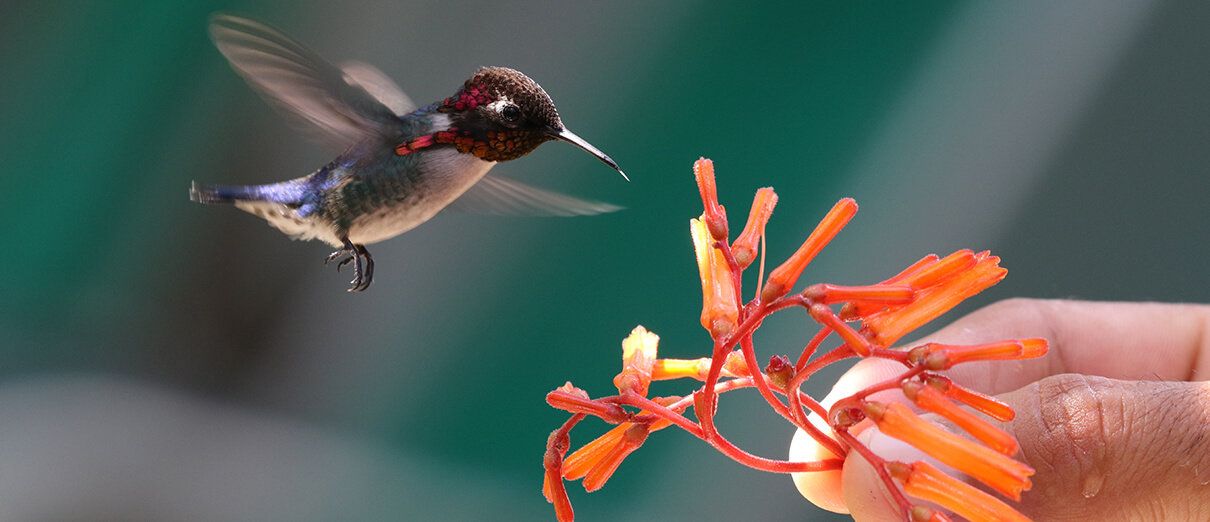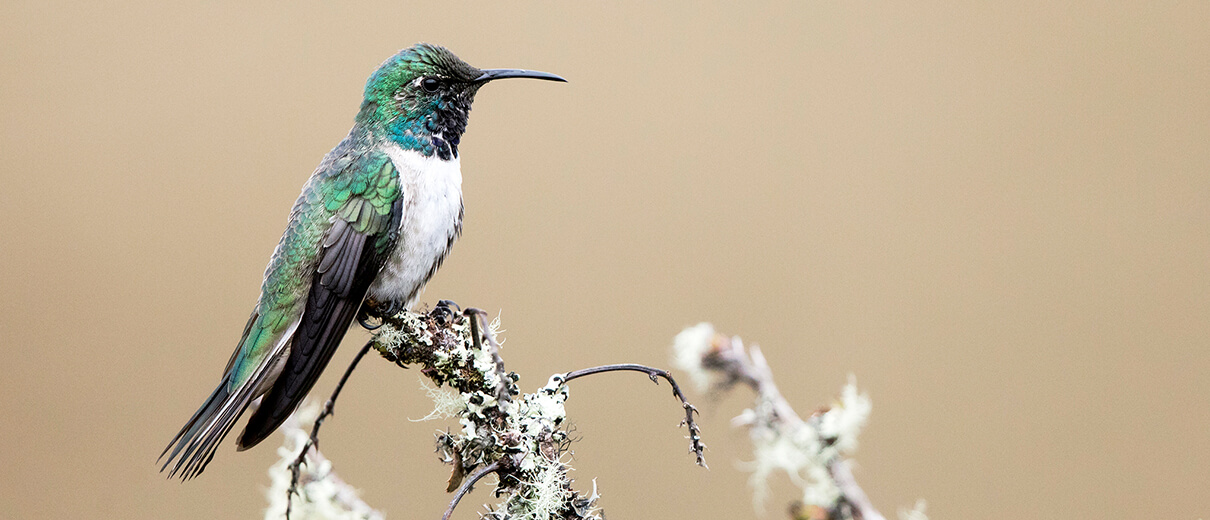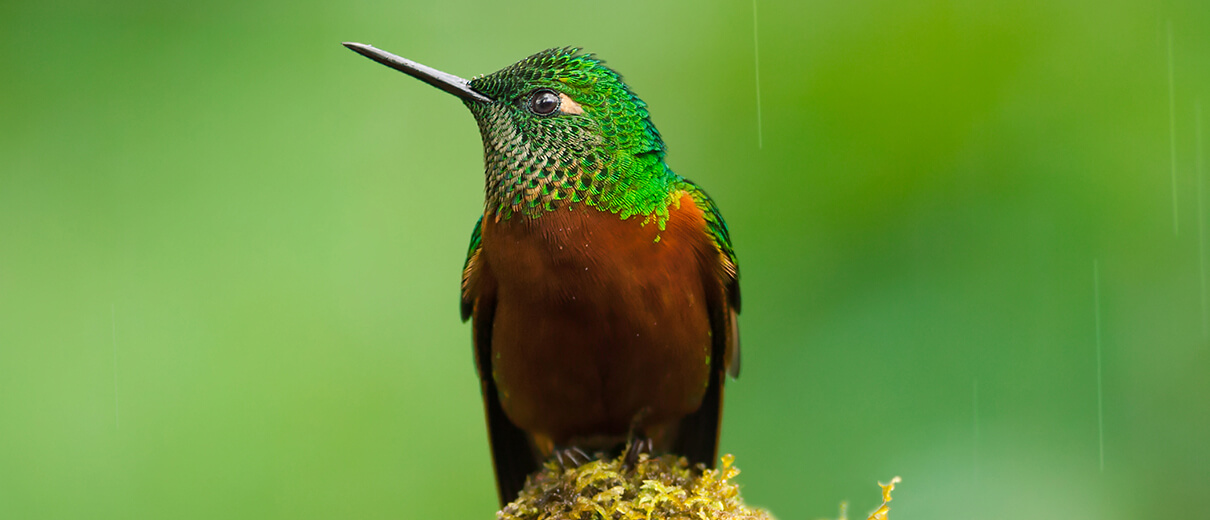Found only in the Americas, hummingbirds are distinguished by their dazzling colors, diminutive size, and speedy flight. You might be familiar with some of the more common species in North America, like the Ruby-throated and Rufous Hummingbirds. But there are hundreds of species in the Americas, from Alaska to Tierra del Fuego.
Hummingbirds have adapted to a wide variety of climates and environments, including desert scrublands and even chilly grassy and bushy areas called páramo, found above the treeline 10,000 or more feet up in the Andes. Unfortunately, habitat loss threatens many species, including ten that are Critically Endangered, such as the Glittering Starfrontlet, Chilean Woodstar, and Juan Fernández Firecrown. All of these species are ecological and cultural treasures, and ABC is working with international partners to protect them and the other species sharing their habitats.
Want to learn more about these tiny wonders and why we need to protect them? Here are 10 fascinating facts about hummingbirds:

With 15 hummingbird species found in the U.S. and several others that pop up there rarely, we see only a fraction of the total number of species. Some are common, like the Ruby-throated Hummingbird, the only species commonly found in the East, and Anna’s Hummingbird, which is found year-round along the West Coast. Others, like the Lucifer Hummingbird, have small U.S. ranges. Still others are rare wanderers like the Berylline Hummingbird, only occasionally found north of the border with Mexico.
The vast majority of hummingbirds are found in tropical areas, with the greatest diversity in the northern Andes. Ecuador, with its diverse landscapes and climates, is home to the largest number – some 130 species.
Hummingbirds have outstanding spatial memory and can remember feeder locations years later. They are also able to keep track of bloom peaks and remember which flowers they’ve visited. This is because a large portion of a hummingbird’s brain is occupied by the hippocampus, an area dedicated to learning and spatial memory.
Hummingbirds have very high energy needs. In order to keep up with their metabolism, they feed continuously throughout the day. The Ruby-throated Hummingbird, for example, can visit more than 1,000 flowers in a day, consuming up to half its weight in nectar between sunrise and sunset. Flowers are their main food source, but hummingbirds also “pay back” many plants because they play an important role in pollination. They pollinate thousands of different plants, including wildflowers that can stabilize fragile soils after fires and landslides.
The aptly named Bee Hummingbird, endemic to Cuba, is only about 2 inches long and weighs approximately 1.6 grams. Other tiny hummingbirds include the 2.5-inch-long Esmeraldas Woodstar, found in Ecuador, and the Frilled Coquette, less than three inches long and the smallest bird in Brazil.

Not all hummingbirds are so small, however. As its name denotes, the Giant Hummingbird, found along the Andes, is “huge” for a hummingbird, at 8 inches long. The Swallow-tailed Hummingbird and Marvelous Spatuletail, both also South American, reach about 6.5 inches long, but much of that is long tail feathers. Similarly, the Sword-billed Hummingbird, another Andean species, has a long bill that makes up nearly half of its 8-inch length.
The Blue-throated Hillstar was discovered as recently as 2017. Researchers estimate that there are fewer than 1,000 individuals, found only in a small region in southwestern Ecuador.

Other species have remained unseen for decades. There was not a single sighting of the Blue-bearded Helmetcrest between 1946 and 2015, when ABC partner Fundación ProAves launched a search and rediscovered the bird in Colombia. Still to be hopefully rediscovered is the Turquoise-throated Puffleg, which is primarily known from specimens collected in Ecuador in 1850 and one unconfirmed sighting in 1976.
The Blue-throated Mountain-gem’s heart beats as fast as 1,260 beats per minute. Costa’s Hummingbird’s beats between 500 and 900 times. Compare that to a human’s average heart rate of 60 to 100 beats per minute. Even more amazing, some hummingbirds can enter a state of torpor, reducing their heart rates to as few as 50 beats per minute to conserve energy and survive cold temperatures.
The name hummingbird comes from the humming sound their wings make as they fly. These birds’ flexible shoulder joints allow their wings to rotate 180 degrees, which enables backward flight and stationary hovering.

Hummingbirds can only perch or scoot sideways. They belong to the bird order Apodiformes (meaning “footless”), which also includes other great aerialists with tiny feet, the swifts. Small feet are an asset both for swifts and hummingbirds because they reduce drag in flight, making these birds more aerodynamic.
The Calliope Hummingbird is the smallest long-distance migratory bird in the world, travelling more than 5,000 miles each year. The Rufous Hummingbird is also a long-distance traveler, taking on a 3,900-mile-long journey. Thanks to the birds’ incredible flight ability, hummingbird migration can be surprisingly fast: The Ruby-throated Hummingbird, for example, makes a nonstop 500-mile journey across the Gulf of Mexico in less than a day.
Today, hummingbirds are exclusive to the Americas, but that was not always the case. The oldest hummingbird fossil was discovered in Germany in 2004. Scientists have yet to explain why hummingbirds disappeared from Europe.

ABC is determined to prevent hummingbird extinctions. We work with partners and local communities to ensure the survival of the most endangered hummingbirds, as well as many other rare, declining bird species and their habitats. With our partners, we have created 93 reserves, spanning close to 1 million acres that protect 234 hummingbird species!
Habitat restoration is another hallmark of our work with hummingbirds. To date, ABC has planted more than 6 million trees and shrubs to revitalize key habitats, and we’re planning to plant 70,000 more.
ABC also conducts field expeditions to search for new, and monitor known, hummingbird populations. These efforts allow us to detect changes in population numbers and identify new threats or changes in the environment that might affect species and their habitats.





